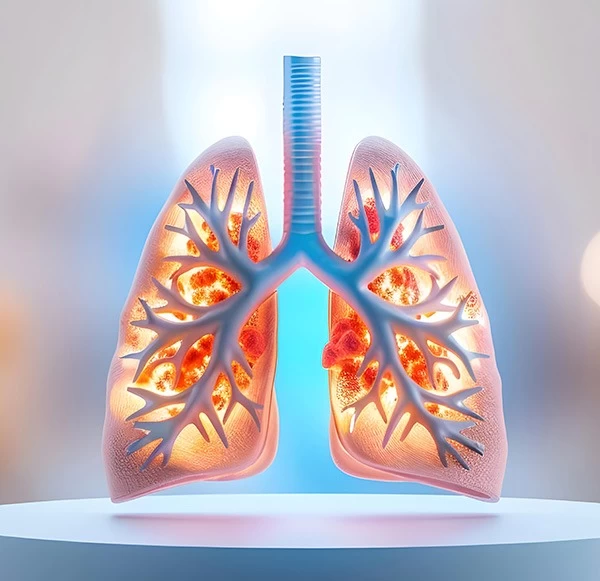- Email Us
-1755765532.webp)
Curious
about the hidden dangers of pancreatic cancer and its subtle signs? The pancreas is a tiny but essential organ that controls blood sugar
and digestion. This disease can grow covertly and go undetected until it is in
a more advanced stage. Although pancreatic cancer presents many difficulties
due to its mild symptoms and rapid spread, knowledge of its causes, warning
indicators, and diagnostic techniques can be extremely helpful. In order to
equip you with the knowledge required for awareness and early action, we
dissect the complexity of pancreatic cancer in this blog, delving into its
symptoms, consequences, diagnostic procedures, and answers to your most
important concerns.
What is
Pancreatic Cancer and How Does it Develop?
The pancreas is a small, yet vital gland located between the stomach and
the spine in the abdomen. It produces digestive enzymes and hormones that
regulate blood sugar levels. One kind of cancer that starts as an abnormal
growth of cells in the pancreas is called pancreatic cancer. Pancreatic ductal
adenocarcinoma is the most prevalent kind of pancreatic cancer. Pancreatic
ducts are typically where pancreatic malignancies begin. Your pancreas and
common bile duct are connected by the major pancreatic duct, also known as the
duct of Wirsung.
According
to trends from recent statistics, pancreatic cancer made up between 1.03 and
1.1% of all new cancer cases in India in 2024. The National Cancer Registry
Programme (ICMR-NCRP) projected that there would be 1,533,000 cancer cases in
India overall in 2024. Pancreatic cancer was expected to account for
15,800–16,900 cases in 2024, maintaining a comparable proportion (~1.03–1.1%),
based on extrapolations from GLOBOCAN 2018 data (10,860 pancreatic cancer cases
out of 1.05 million overall cancer cases, or ~1.03%) and considering the rising
trend. In India, it is the eleventh most prevalent type of cancer.
Pancreatic cancer is notoriously difficult to detect early, when the
chances of a cure are highest, because it often remains silent, showing no
symptoms until it has spread to other organs. Early-stage tumors are
particularly elusive, as they rarely appear on imaging tests, leading to
diagnoses only after the cancer has metastasized. Compounding this challenge,
pancreatic cancer is highly resistant to many standard cancer drugs, making
effective treatment a significant hurdle.
Signs
and Symptoms of Pancreatic Cancer:
Pancreatic
cancer is often called a "silent disease" because it typically shows
no symptoms until it has reached an advanced stage, making early detection
challenging. When symptoms do emerge, they arise as the tumor begins to affect
other organs in the digestive system, signaling that the cancer may have
already spread. Common signs and symptoms of pancreatic cancer may include:
· Dark
urine
· Jaundice
(yellowing of your skin)
· Fatigue
· Itchy
skin
· Nausea
and vomiting
· Gas
or bloating
· Lack
of appetite
· Upper
abdominal pain
· Middle
back pain
· Weight
loss
· New-onset
diabetes
· Blood
clots
Serious Health Complications of Pancreatic Cancer:
Due to
its silent evolution, pancreatic cancer is frequently detected at an advanced
stage. As the tumor grows and impacts the pancreas and adjacent structures, it
can cause a number of catastrophic consequences. These issues result from the
cancer's influence on the pancreas's essential roles in blood sugar management
and digesting, as well as its propensity to spread to other organs. The
following are the main side effects of pancreatic cancer:
· Jaundice: When
tumors obstruct the bile duct, itching, black urine, and yellowing of the skin
result.
· Pancreatic
insufficiency: Weight loss, diarrhea, and greasy stools are
caused by blocked ducts (such as the duct of Wirsung), which hinder digestion.
· Diabetes: 20–40%
of patients develop new or worsened diabetes as a result of damage to
insulin-producing cells.
· Abdominal
Pain: Severe pain or intestinal blockage can result from tumor strain on
nerves or organs.
· Metastasis: In 70–80%
of late-stage patients, cancer worsens when it spreads to the liver, lungs, or
peritoneum.
· Cachexia: Strength
and treatment tolerance are diminished by extreme weight loss and muscle
atrophy.
· Blood
Clots: Dangerous thrombosis or pulmonary embolism are caused by an elevated
risk of clotting.
· Chronic
Pancreatitis: Inflammation brought on by tumors results in
ongoing pain and damage to the pancreas.
Diagnosis
of Pancreatic cancer:
Pancreatic
cancer, often elusive in its early stages, requires precise diagnostic tools
for accurate identification and staging. Facilities such as Mahajan Imaging
& Labs play a pivotal role. With over three decades of experience since
their establishment, Mahajan Imaging & Labs has been at the forefront of performing
these essential tests, leveraging advanced technologies like AI-driven
ultra-fast MRI and PET-CT systems, alongside a team of expert healthcare
professionals. Our patient-centric approach emphasizes timely reporting,
ensuring results are delivered punctually to support swift clinical decisions.
Below are the key diagnostic tests for pancreatic cancer, which are expertly
conducted to aid in early detection and management:
· Fine
Needle Aspiration (FNA): Usually assisted by CT or ultrasound imaging, this
technique uses a thin needle to remove cells from a suspected pancreatic tumor.
· Magnetic Resonance Cholangiopancreatography (MRCP): A
non-invasive form of magnetic resonance imaging, this shows the pancreatic and
bile ducts in great detail and can detect abnormalities or obstructions caused
by tumors.
· Pancreatic blood tests: Measure
enzymes like lipase and amylase to measure pancreatic function as well as
biomarkers, which may be elevated in pancreatic cancer.
· CT
Scans: Offers cross-sectional images of the pancreas,
highlighting tumors, their dimensions, and any metastasis to adjacent organs
like the liver.
· MRI
(Magnetic Resonance Imaging): This
technique delivers high-resolution views of pancreatic tissues and surrounding
areas, aiding in tumor detection and metastasis assessment.
· PET
Scans (Positron Emission Tomography): By
detecting metabolically active areas, PET scans, often paired with CT (PET-CT),
help stage the cancer and identify distant spread, guiding tailored treatment
strategies.
In
conclusion:
Prevention and early diagnosis are critical in the fight against
pancreatic cancer, a disease often undetected until its later stages.
Recognizing symptoms like jaundice or unexplained weight loss can prompt timely
action, significantly improving outcomes. Mahajan Imaging & Labs, with over
35 years of expertise, provides advanced diagnostic tests like MRCP and PET-CT,
delivered with patient-centric care and punctual reporting. By prioritizing
awareness and early testing, you can take proactive steps to safeguard your
health. Book your test through our website, WhatsApp (+91 88828 97661), or by
calling our support team (+91 11 4118 3838), with options for in-centre testing
or convenient home sample collection.
Don’t
ignore symptoms—early pancreatic cancer testing saves lives. Visit
Mahajan Imaging & Labs for advanced diagnostics like MRCP and PET-CT.
Schedule your screening today!




